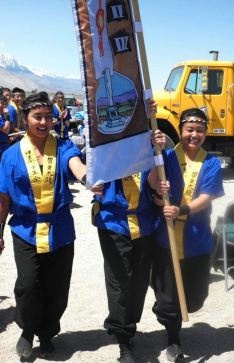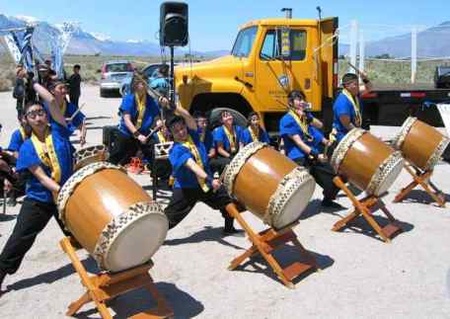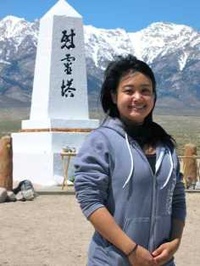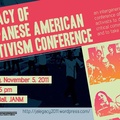The dust stirred gently in the opaque light of the rising sun, drifting along the near empty road. Eyes still drowsy from the four-hour trip, mind still struggling to awake from rising with the dawn light, we finally reached the parking lot which would lead to the Manzanar National Historic Site—my second time at the annual Manzanar Pilgrimage since my freshman year at UCLA.
When I went to my first Manzanar Pilgrimage in April 2009, I had absolutely no idea what to expect. I was only newly exposed to the history of Japanese American Internment, and now, physically stepping into the forlorn desert they had once been forced to call home brought forth mixed emotions.
What does it mean to be a (Japanese) American of this generation?
I distinctly remember the car ride my first year, when one of my upperclassmen and Board member of the UCLA Nikkei Student Union (NSU), Ed Kobayashi, elaborated on how Manzanar was one of the two internment camps in California during World War II, and every year, people from all walks of life come to make a pilgrimage to this historic site.
My initial feeling of detachment and indifference was borne from my ignorance—I knew it was significant but it was easy to listen to how the internees had to suffer, but not truly understand or comprehend the weight of those words.
Oh how the times have changed.
Memories of standing in the scorching sun amid the barren landscape along with my fellow NSU members dominated my initial impression of the camp. But this time, as a college junior, I searched for familiarity. My purpose on this pilgrimage was different. No longer was I making the pilgrimage for the organization which I was a part of, almost devoid of any knowledge of internment and Japanese Americans, Instead, I arrived as someone who had gained familiarity with the rich history.
Indeed, since my freshman year of college, I was able to become immersed in the history, and all which had transpired among Japanese Americans through my vivid experience at Manzanar, and my experiences in NSU and at the Japanese American National Museum (JANM) in the years thereafter.
Experiencing the hot, dry heat of the desert, sleeping in the freezing temperatures at night at our camp site near Manzanar, listening directly to the stories by the Nisei, and seeing how many generations the stories touched, truly moved my heart.
As two years had gone by since my last visit, I still held tightly to that memory. But as time passes, so does the land, and so do the people.

There was familiarity and yet a distinct feeling of a change—a transition I had completely missed. All the upperclassmen who had accompanied me on my previous trip were nowhere to be found. To be sure, no longer was I just a mere observer this year, as I had the honor and privilege to perform with UCLA Kyodo Taiko to support the event, and was asked to carry the Poston banner with Eryn Tokuhara and Michelle Cheng, two of my fellow Kyodo members, in recognizing the ten different internment camps.
With the wind blowing, it was quite a trial for three small women to hold up the large banner. This experience brought to heart another dose of realization: being embraced into the Nikkei community.
Moreover, as I stood there holding the Poston banner, the man beside me inquired as to where I was from and what high school I attended. Little did I expect to meet one of the physical education teachers, Mr. Beadles, from Nobel Middle School (located in Northridge, California), at Manzanar. It struck me how small the world really is, and how far-reaching the Manzanar Pilgrimage and its message is.
The greatest difference between my first Pilgrimage and this year’s event was definitely the people I encountered, particularly with the Manzanar At Dusk (MAD) program. I remembered my first year—my discussion group had two elderly former internees who recounted their experiences in the camps: the confusion at being told to pack up their belongings in a single suitcase, the loyalty questionnaire, and that fighting in the war was a testament to the strength of the Japanese American community.
But this year, it was evident that the number of former internees has dwindled, and the majority of them in the MAD discussion group I was part of were too young to vividly remember their experiences. In fact, one was so young that he was born in camp during World War II. As such, they could only say so much from what they could remember, if anything. Most of what they could do was pass on the stories and experiences passed onto them from the previous generations—over sixty years have passed since internment occurred in the United States during the Second World War.
I am no longer the newbie who is completely unaware of the gravity of what occurred at Manzanar, the strength and sheer willpower of the Japanese American population, and the potential for invoking the impact each one of us holds to create change. Regardless of whether my grandparents may have been interned, as an American of this generation, I hold close to my heart the words of those with whom I had the privilege to speak at Manzanar At Dusk.
“As the next generation, you have a duty to not just hold what you hear today within you, but to pass it on.”
To be sure, the experience has the potential to touch more than one life.
Although many printed press, media, and interviews may have brought their stories to the light, what holds the greatest influence is directly hearing, not only from those who went through the experience, but from those who were touched by it. History repeats itself, not only because of the actors who play in the grand scheme of things, but by those who refuse to confront it and to apply the lessons learned by those who make the sacrifices. Nothing should ever be taken for granted.
Shikata ga nai. It cannot be helped. Perhaps we cannot change the past—that is truly sho ga nai. But we must take what we have learned and take action—never forget, but move on confidently, upholding the flow of time between generations. Issho ni ganbarimashou. Let us all work hard together, never forgetting, passing it on, and paying it forward.

*The views expressed in this story are those of the author, and are not necessarily those of the Manzanar Committee.
**This article was originally published on August 13, 2011 on the Official Blog of the Manzanar Committee.
© 2011 Yoshimi Kawashima






